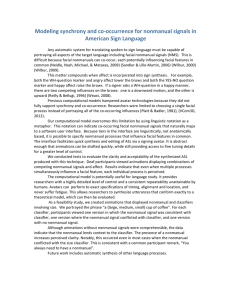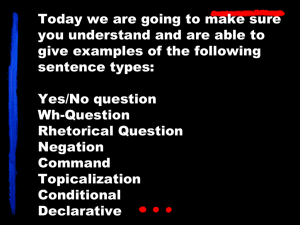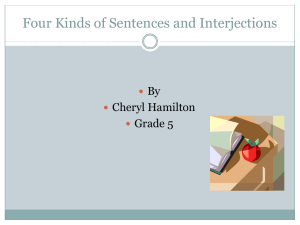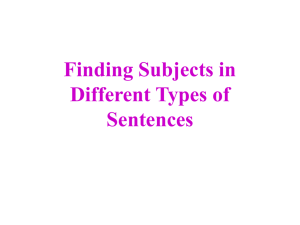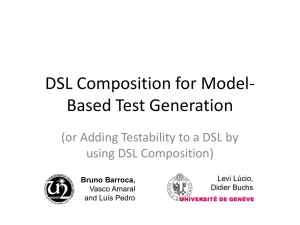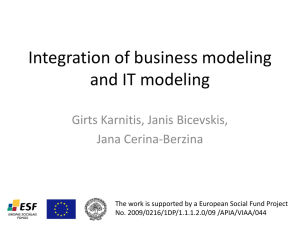PPT - Purdue University
advertisement
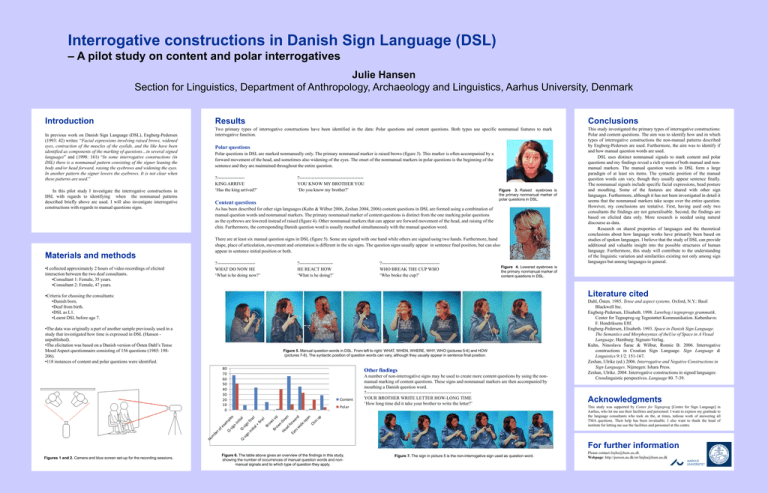
Interrogative constructions in Danish Sign Language (DSL) – A pilot study on content and polar interrogatives Julie Hansen Section for Linguistics, Department of Anthropology, Archaeology and Linguistics, Aarhus University, Denmark Introduction In previous work on Danish Sign Language (DSL), Engberg-Pedersen (1993: 42) writes: “Facial expressions involving raised brows, widened eyes, contraction of the muscles of the eyelids, and the like have been identified as components of the marking of questions…in several signed languages” and (1998: 161) “In some interrogative constructions (in DSL) there is a nonmanual pattern consisting of the signer leaning the body and/or head forward, raising the eyebrows and widening the eyes. In another pattern the signer lowers the eyebrows. It is not clear when these patterns are used.” Results Conclusions Two primary types of interrogative constructions have been identified in the data: Polar questions and content questions. Both types use specific nonmanual features to mark interrogative function. This study investigated the primary types of interrogative constructions: Polar and content questions. The aim was to identify how and in which types of interrogative constructions the non-manual patterns described by Engberg-Pedersen are used. Furthermore, the aim was to identify if and how manual question words are used. DSL uses distinct nonmanual signals to mark content and polar questions and my findings reveal a rich system of both manual and nonmanual markers. The manual question words in DSL form a large paradigm of at least six items. The syntactic position of the manual question words can vary, though they usually appear sentence finally. The nonmanual signals include specific facial expressions, head posture and mouthing. Some of the features are shared with other sign languages. Furthermore, although it has not been investigated in detail it seems that the nonmanual markers take scope over the entire question. However, my conclusions are tentative. First, having used only two consultants the findings are not generalisable. Second, the findings are based on elicited data only. More research is needed using natural discourse as data. Research on shared properties of languages and the theoretical conclusions about how language works have primarily been based on studies of spoken languages. I believe that the study of DSL can provide additional and valuable insight into the possible structures of human language. Furthermore, this study will contribute to the understanding of the linguistic variation and similarities existing not only among sign languages but among languages in general. Polar questions Polar questions in DSL are marked nonmanually only. The primary nonmanual marker is raised brows (figure 3). This marker is often accompanied by a forward movement of the head, and sometimes also widening of the eyes. The onset of the nonmanual markers in polar questions is the beginning of the sentence and they are maintained throughout the entire question. ?-----------------KING ARRIVE ‘Has the king arrived?’ In this pilot study I investigate the interrogative constructions in DSL with regards to identifying when the nonmanual patterns described briefly above are used. I will also investigate interrogative constructions with regards to manual questions signs. ?-----------------------------------------YOU KNOW MY BROTHER YOU ‘Do you know my brother?’ Figure 3. Raised eyebrows is the primary nonmanual marker of polar questions in DSL. Content questions As has been described for other sign languages (Kuhn & Wilbur 2006, Zeshan 2004, 2006) content questions in DSL are formed using a combination of manual question words and nonmanual markers. The primary nonmanual marker of content questions is distinct from the one marking polar questions as the eyebrows are lowered instead of raised (figure 4). Other nonmanual markers that can appear are forward movement of the head, and raising of the chin. Furthermore, the corresponding Danish question word is usually mouthed simultaneously with the manual question word. There are at least six manual question signs in DSL (figure 5). Some are signed with one hand while others are signed using two hands. Furthermore, hand shape, place of articulation, movement and orientation is different in the six signs. The question signs usually appear in sentence final position, but can also appear in sentence initial position or both. Materials and methods ?------------------------WHAT DO NOW HE ‘What is he doing now?’ •I collected approximately 2 hours of video recordings of elicited interaction between the two deaf consultants. •Consultant 1: Female, 35 years. •Consultant 2: Female, 47 years. ?---------------------HE REACT HOW ‘What is he doing?’ ?-------------------------------------WHO BREAK THE CUP WHO ‘Who broke the cup?’ Figure 4. Lowered eyebrows is the primary nonmanual marker of content questions in DSL. Literature cited •Criteria for choosing the consultants: •Danish born. •Deaf from birth. •DSL as L1. •Learnt DSL before age 7. •The data was originally a part of another sample previously used in a study that investigated how time is expressed in DSL (Hansen unpublished). •The elicitation was based on a Danish version of Östen Dahl’s Tense Mood Aspect questionnaire consisting of 156 questions (1985: 198206). •118 instances of content and polar questions were identified. Figure 5. Manual question words in DSL. From left to right: WHAT, WHEN, WHERE, WHY, WHO (pictures 5-6) and HOW (pictures 7-8). The syntactic position of question words can vary, although they usually appear in sentence final position. 80 70 60 50 40 30 20 10 0 Other findings Content He ow ad n fo rw Ey es ar d wi de op en Ch in up p Br o ws d ws u Br o al fin al + fin al iti in sig n Q- sig n iti in sig n Q- Acknowledgments This study was supported by Center for Tegnsprog [Centre for Sign Language] in Aarhus, who let me use their facilities and personnel. I want to express my gratitude to the language consultants who took on the, at times, tedious work of answering all TMA questions. Their help has been invaluable. I also want to thank the head of institute for letting me use the facilities and personnel at the centre. Q- Nu m be r of ex am pl al es Polar A number of non-interrogative signs may be used to create more content questions by using the nonmanual marking of content questions. These signs and nonmanual markers are then accompanied by mouthing a Danish question word. ?--------------------------------------------------------------------YOUR BROTHER WRITE LETTER HOW-LONG TIME ‘How long time did it take your brother to write the letter?’ Dahl, Östen. 1985. Tense and aspect systems. Oxford, N.Y.: Basil Blackwell Inc. Engberg-Pedersen, Elisabeth. 1998. Lærebog i tegnsprogs grammatik. Center for Tegnsprog og Tegnstøttet Kommunikation. København: F. Hendriksens Eftf. Engberg-Pedersen, Elisabeth. 1993. Space in Danish Sign Language. The Semantics and Morphosyntax of theUse of Space in A Visual Language. Hamburg: Signum-Verlag. Kuhn, Ninoslava Šarac & Wilbur, Ronnie B. 2006. Interrogative constructions in Croatian Sign Language. Sign Language & Linguistics 9:1/2. 151-167. Zeshan, Ulrike (ed.) 2006. Interrogative and Negative Constructions in Sign Languages. Nijmegen: Ishara Press. Zeshan, Ulrike. 2004. Interrogative constructions in signed languages: Crosslinguistic perspectives. Language 80. 7-39. For further information Figures 1 and 2. Camera and blue screen set-up for the recording sessions. Figure 6. The table above gives an overview of the findings in this study, showing the number of occurrences of manual question words and nonmanual signals and to which type of question they apply. Figure 7. The sign in picture 5 is the non-interrogative sign used as question word. Please contact linjha@hum.au.dk. Webpage: http://person.au.dk/en/linjha@hum.au.dk
